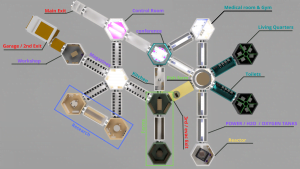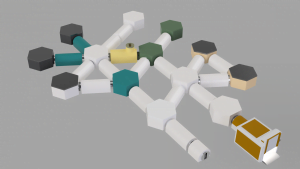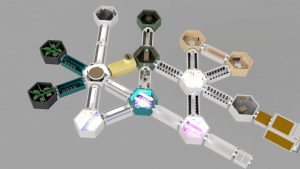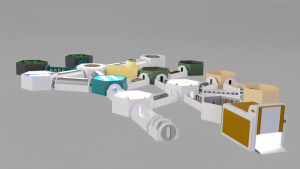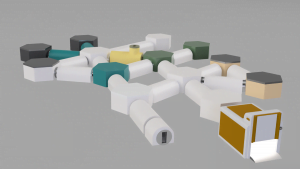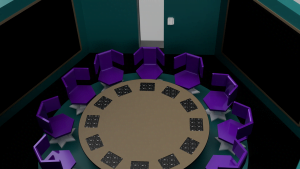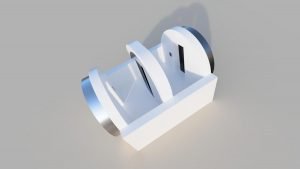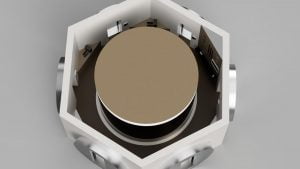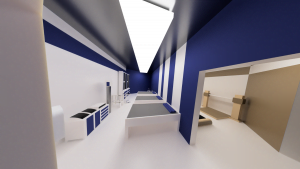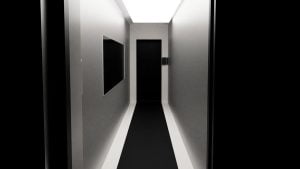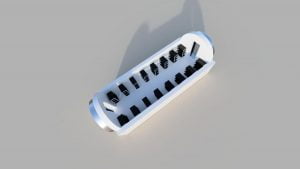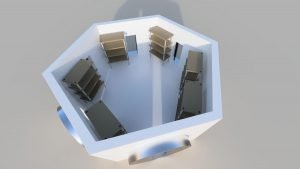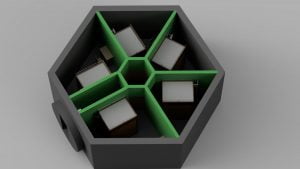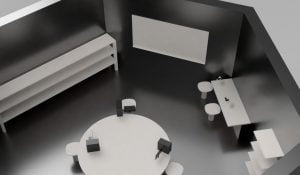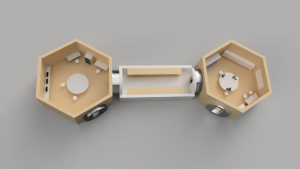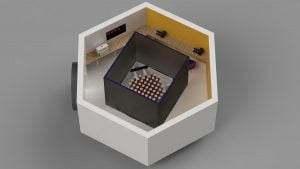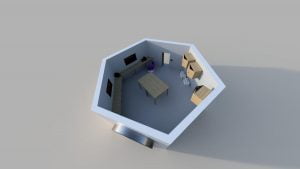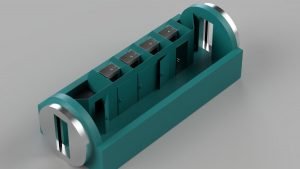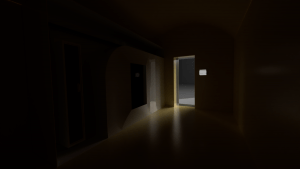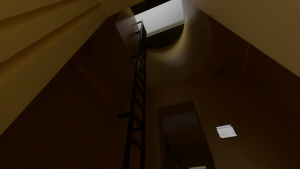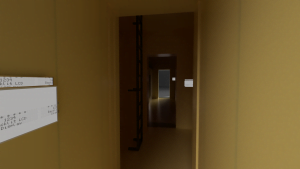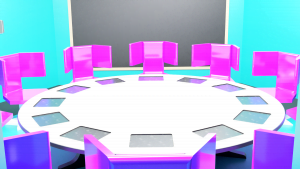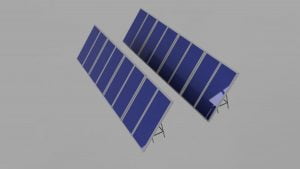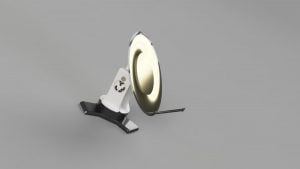Moon Camp Pioneers Gallery 2020-2021
In Moon Camp Pioneers each team’s mission is to 3D design a complete Moon Camp using Fusion 360. They also have to explain how they will use local resources, protect astronauts from the dangerous of space and describe the living and working facilities.
Team: New Tech Team 7570
Technikum New Technology Zamość Poland 17, 16, 18, 19
External viewer for 3d project
|
Project description
Our base was established as a side project of several members of the New Tech Team 7570 from Zamość: Przemysław, Andrzej, Jakub, Wictoria and Bartłomiej. We conducted the work independently for over 4 months, based on publicly available scientific studies and data. Our base has been designed as a full-size research facility habitable throughout the whole lunar cycle. Our project is characterized by redundancy, safety and a strong emphasis on astronaut comfort and productivity. Our main goal was to create a friendly environment for life and work, which is why we grouped the rooms into 3 types:
The entire facility is supposed to be operated by a single integrated computer system that will take care of station parameters, automatic functions, and safety. The interfaces for operating this system are located next to every door throughout the facility. In order that in the event of a failure of one of the modules, the road to the next was not cut off, we decided on the aforementioned redundancy. Most base modules can be accessed in at least two ways. The base also has two main outputs and one additional emergency output. The project shows final construction of the base. Due to the covering of the facility with regolith after completion of construction, it will not be possible to easily expand it. |
|||
|
Where do you want to build your Moon Camp?
We plan to build our base in one of the micro-craters on the southwest edge of Shackleton Crater. Kratet Shackleton is known for the fact that for more than 80% of each orbital cycle of the moon, it is exposed to sunlight. Temperature amplitudes are much smaller there, and the environment is a little more human-friendly in this respect. In addition, the practical constant exposure of its slopes to solar radiation makes it a very favorable location for powering the station through photovoltaic panels. By contrast, the depth of the crater is completely hidden from solar radiation, so there is probably ice in sufficient quantities to cover the base needs. How do you plan to build your Moon Camp? Describe the techniques and materials you would use.
Working on our base, we were inspired by the schematic of the construction of the ISS. We based the base structure on two key modules: the connector and the appropriate task module. Each of them can be built from separate, smaller elements, which will facilitate the time-consuming and expensive transport of modules to the surfaces of the silver globe. We divided the construction of the base into 4 stages:
The environment on the Moon is very dangerous for the astronauts. Explain how your Moon Camp will protect them.
The main threats to astronauts settling on the moon are: Temperature amplitude, micrometeors and cosmic radiation. All three hazards can be avoided to some extent by covering the base with a thick, several-meter layer of regolith. This layer will act as thermal isolation from surface conditions. Adding to this the heating systems inside the base, which will be activated for the time when the resort will be located at the unlit part of the moon, this should allow for favorable conditions for work and life for astronauts. The regolith layer should also protect astronauts from radiation by acting like a thick layer of concrete. In order to reduce the possibility of radiation penetration into the base and the loss of heat energy, the walls of the base modules will be made of several layers of stainless steel, hardened aluminum, kevlar, polymers and materials, used for thermal insulation, and radiation shielding. Explain how your Moon Camp will provide the astronauts with:
|
|||
|
Water
|
Food
|
Electricity
|
Air
|
|
Water will be delivered to the base along with lunar regolith by lunar rovers and other autonomous vehicles. Ice crystals extracted from regolith will require several filtering steps before they can be consumed. That’s why we decided to use them as coolant for reactor, which are one of the power sources of the base. Ice, taking heat from the reactor, will turn into water steam to power the turbine. Then the hot water will continue to be directed to a separate circuit. In this circuit, going throughout the base, it will give heat energy to the inside of the base, thus providing suitable conditions for the inhabitants of the base. Heating system, in different places will also include carbon filters, additionally purifying water. At the end of the circuit, however, there will be the last stage responsible for mineralizing water so that it is suitable for consumption. |
Plants such as arugula, tomatoes, watercress, radish, quinoa, chives, peas, soybeans and leeks can be grown in moon soil. Rocket, watercress and radish also produce seeds on it. The gradual fertilization of the soil with the help of natural fertilizer produced by the inhabitants of the station may allow, in the long term, to grow other plants, and possibly to obtain seeds. To protect the culture from radiation, it will be in two modules, placed like the rest of the base under a thick layer of regolith. Plants will therefore be grown under artificial light. The farm will be watered by a system of sprinklers suspended from the ceiling of the module. Additionally, together with the astronauts, the fertilized roe will be sent to the stations, from which they should be able to raise fish on the spot. One of the modules will have an aquarium intended for this purpose. |
To increase the security of the base, we decided to use two independent power systems. The first and main source of power are, of course, photovoltaic panels that are very effective in these conditions. But to provide redundancy, and ensure safety, we decided to place an emergency power source in the base in the form of nuclear reactor (with limited power to minimize the risk of radiation of the base and a catastrophe). In the event of damage to the installation of photovoltaic panels, it will be possible to temporarily increase the power of the generator so that they temporarily supplement the shortages in power supply for the elements strategic for the operation of the base. This will give the residents of the base time to repair the damaged installation, without fear of losing power and thus stopping the life support installations in the base. |
Tanks with oxygen and other elements that make up the air suitable for human breathing will originally have to be delivered to the base from the earth. Due to the fact that a person in the process of breathing consumes only oxygen, and the rest of the elements are returned to the atmosphere, it will be necessary to replenish only oxygen. Some of the required oxygen will be replenished by plants, but a small number of plants grown at the station will not be able to replenish the stock of this element on an ongoing basis. Therefore, part of the drinking water produced for the base will be subjected to electrolysis. Large amounts of oxygen are also found in the regolith using the appropriate apparatus, it would be possible to separate sufficient amounts of this element. |
|
Explain what would be the main purpose of your Moon Camp (for example: commercial, scientific, and/or tourist purposes).
The base would be primarily a research center aimed at studying the possibility of obtaining various raw materials from the moon and the possibility of using them in further space exploration and commercial applications. At the beginning of its existence, the facility will put special emphasis on conducting research on the mass acquisition of the given elements and chemical compounds from deposits and compounds available on the moon’s surface
Hydrogen, Oxygen and Methane are the main components of CH4/LOX rocket fuel. Hydrogen can be obtained in trace amounts from the atmosphere and by electrolysis from lunar ice water. Oxygen can be easily obtained both through electrolysis and from lunar regolith. It would also be crucial to obtain Helium-3, which has properties that are highly desired in many industries, and its resources on earth are very limited. |
|||
|
Describe a day on the Moon for your Moon Camp astronaut crew.
The daily cycle, along with the life support systems at the station, will be supported by the station’s on-board computer, which interfaces will be located by the left side of every door inside the station. The station has been designed to provide comfortable working and living conditions for 10 people. The daily cycle will be divided into three 8-hour parts. Eight people from the station’s staff will be working according to the cycle determined by the system, while two other base residents will work while the rest of the crew is asleep. People working in an alternative daily cycle they will control the parameters of the station, maintain a connection with the earth. Such a division will ensure that the base will never be left without human supervision, and thus increase the safety of its inhabitants. Every week there will be a change of people working in the alternative daily cycle. Normal daily astronauts will start their day with a morning toilet and a meal, which they will eat together in the meeting room. They will have an hour to do so from the moment the system wakes them up. Then, the 8 hours shift will begin, with the briefing, i.e. the division of duties and tasks for a given day. Each of the base employees will take care of other duties and elements of the station according to their specialization. After the end of the 8-hour shift, there will be lunch, after which base employees will have about 4.5 hours to themselves, during which they will be able to connect with their families, relax, check what is happening on the earth via the Internet, etc. The next 2 hours will be devoted to training in the gym, (which due to low gravity will be compulsory for the residents of the base), as well as taking care of hygiene and eating the next meal. The last 8 hours of the daily cycle will of course be devoted to sleep. |
|||


